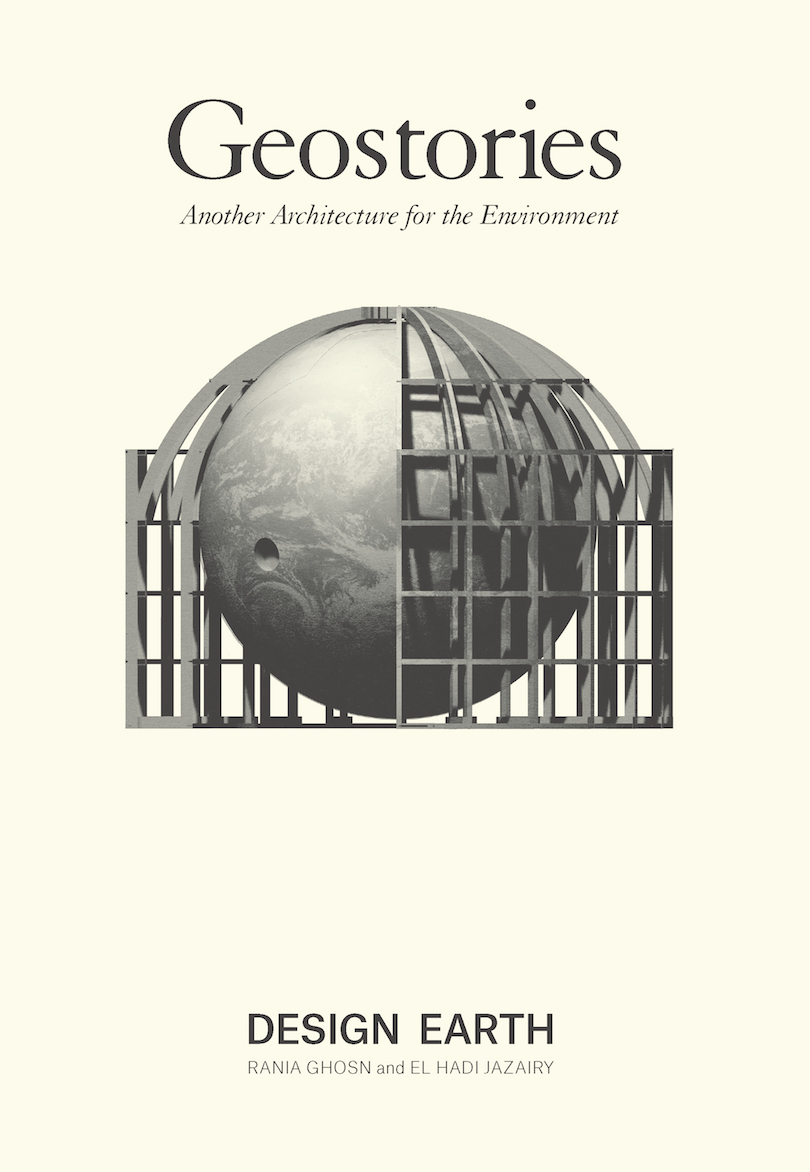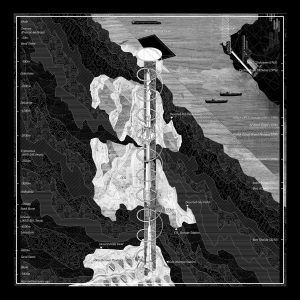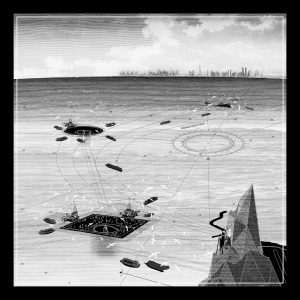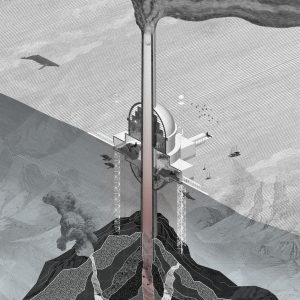Rania Ghosn and El Hadi Jazairy (Design Earth)
Actar

Framing Geostories in this way is more or less how Rania Ghosn and El Hadi Jazairy, founding partners of Design Earth, position their own work. For them, sci-fi offers opportunities to expand the scale and scope of architectural discourse to “reflect on reality without realism, without optimization, without determinism, and without fear of the cosmic scale” (21). If Kim Stanley Robinson’s Science in the Capital trilogy, N. K. Jemisin’s Broken Earth trilogy, and other exemplary works of cli-fi conjure their worlds through the written word, Ghosn and Jazairy construct theirs primarily through visual means. They use conventional types of architectural drawings—section and axonometry, in particular—to speculate on and render legible the atmospheric, ecological, geological, geopolitical, economic, industrial, technological, social, and perceptual conditions of a damaged planet with an uncertain future.


Their drawings of Das Island, an offshore Emirati oil- and gas-producing facility in the Persian Gulf reimagined as part of the After Oil series, are illustrative. The first is a section through depleted oil reservoirs with hundreds of millions of years of geological formations drawn in the poché and prominent works of late twentieth- and early twenty-first-century Gulf architecture, like the Burj Khalifa, stacked vertically in the facility’s subterranean shaft. The second depicts an artificial mountain made of material excavated during drilling, a monument to and a product of the often-unseen process of extraction. The final drawing shows a series of shaft openings dotting the Gulf waters, with a ghostly Dubai skyline on the horizon. These drawings manage to compress multiple, seemingly incompatible, scales into one unified image. In the first drawing, for example, the almost unfathomable depths of geological time are literally overlaid with the frenetic tokens of petro-capitalism. They also combine scientific precision—nautical charting is projected onto the waters of the third drawing—with a kind of wry sublimity. In the same drawing, two minuscule humans atop the artificial mountain recall similar figures in nineteenth-century landscape paintings, overwhelmed here by the consequences of the Anthropocene rather than the grandeur of Nature.

These and the other drawings that compose Geostories are organized into three categories—Terrarium, Aquarium, and Planetarium—which also form the basic structure of the book. The movement implied by these headings, from the terrestrial through the oceanic to the cosmic, is less about scaling up than it is about shifting readers’ perspectives to bring new problems, new phenomena, and new possibilities into focus. This is apparent in the way that certain themes are carried across the three sections. Chief among them is refuse. Many of the projects in Geostories make visible and therefore comprehensible the sheer quantities of waste produced through resource extraction, space exploration, and mass consumption. In one project, decommissioned satellites and spacecraft are brought back to Earth and assembled into a “space junk” archipelago that would house refugees from Pacific Islands that have been swallowed by rising sea levels. The projects are also littered with the detritus of modern architectural history. Vladimir Tatlin’s Monument to the Third International is repurposed as part of a Korean landfill; the Empire State Building becomes part of a deep-sea mining operation and, elsewhere, an ark to carry nearly extinct species into space; Le Corbusier’s Radiant City, Kenzo Tange’s plan for Tokyo Bay, and a variety of other urban visions are rendered as interchangeable parts of a real-estate chessboard spanning the Strait of Hormuz. Reckoning with the ugly material legacies of the modern era is just as necessary, Ghosn and Jazairy seem to be saying, as coming to terms with its failed utopian alternatives.

At times, these speculations teeter on the edge of agnosticism. A cynical reader might interpret Geostories as little more than an attempt to aestheticize the slow-motion destruction of the planet. Yet, a more careful reader of the book’s intricate and provocative drawings would understand them as efforts to use architecture’s forms and conventions to push at the limits of the discipline’s self-understanding and, more broadly, to affect a kind of cognitive estrangement. This is how Geostories so successfully translates the potential of cli-fi from literary into architectural terms. Unlike the moralizing utopias of the nineteenth and early twentieth centuries, with their unwavering faith in social and technological progress, or the later dystopias that reveled in a nuclear-armed humanity’s potential to destroy itself and the planet, cli-fi forges a more nuanced path between the inevitability of an apocalypse and the availability of a panacea. Geostories challenges its readers to grasp the immensity of the problems the planet and its inhabitants face. But it also equips them to imagine a way forward, however unnerving and precarious that way may be.

Endnotes:
Joseph M. Watson is an architectural and urban historian. He studies architects’ efforts to manage changing social, economic, and environmental conditions in the cities and suburbs of the twentieth-century United States. He received a PhD in the History and Theory of Architecture program at the University of Pennsylvania in 2018 and is currently an instructor of architecture at Louisiana State University. His writings have appeared in the Avery Review, Journal of Architectural Education, Journal of Urban History, Planning Perspectives, and Thresholds.
How to Cite This: Watson, Joseph M. Review of Geostories: Another Architecture for the Environment by Rania Ghosn and El Hadi Jazairy (Design Earth), JAE Online, May 15, 2020. http://www.jaeonline.org/articles/review/geostories#/.
All images used in this review are the copyright of Rania Ghosn and El Hadi Jazairy (Design Earth).






